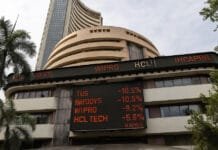Share Market Opening Bell: Sensex, Nifty Dip Amid Renewed Tariff Concerns
The Indian stock market opened on a cautious note today, with benchmark indices sliding into the red shortly after the bell rang. Geopolitical tensions, particularly the resurgence of US-India trade tariff fears, weighed heavily on investor sentiment, dragging both Sensex and Nifty lower in early trade.
Markets Open Weak Amid Global Trade Headwinds
At the opening bell, the BSE Sensex was down by over 350 points, slipping below the 74,000 mark, while the NSE Nifty 50 shed more than 100 points, breaching the critical 22,450 level. The downtrend was broadly in line with other Asian markets, which reacted nervously to the latest cues from Wall Street, where worries about new US tariffs on Indian goods rattled investors.
Key Indices Performance at Open
Sensex: Opened at 73,820.31, down 371.44 points or 0.50%
Nifty 50: Opened at 22,442.75, down 112.15 points or 0.50%
Both indices have since seen range-bound movement, with sellers dominating the early hours.
Major Drag: Metal, Auto, and IT Stocks Under Pressure
Sectors sensitive to global trade flows, particularly metal and auto stocks, were among the top losers. The Nifty Metal index fell over 1.2% in early trade, as companies like Tata Steel, JSW Steel, and Hindalco faced heavy selling.
IT stocks, usually seen as resilient in tough macroeconomic environments, also bore the brunt. Heavyweights like Infosys, TCS, and Wipro slipped up to 0.8%, tracking weakness in Nasdaq futures and the continued pressure from an appreciating Indian Rupee.
Top early losers on Nifty 50 included:
JSW Steel: -1.65%
Tata Motors: -1.43%
Infosys: -0.91%
Mahindra & Mahindra: -0.88%
Hindalco: -1.37%
Tariff Tensions Reignite Investor Anxiety
The market sell-off comes in the backdrop of renewed speculation around US President Donald Trump’s protectionist policies, including a proposed 25% tariff hike on key Indian exports. If implemented, such measures would directly impact India’s trade surplus with the US, raising concerns across auto component, pharmaceutical, and textile sectors.
Investors fear that retaliatory tariffs from the Indian government could escalate tensions and trigger a full-blown trade war, affecting GDP growth and corporate earnings in the coming quarters.
Global Cues: Asian Markets Mirror Risk-Off Sentiment
Asian peers opened in the red, reflecting global uncertainty:
Nikkei 225: -0.56%
Hang Seng: -1.12%
Shanghai Composite: -0.67%
Kospi: -0.49%
This widespread sell-off has exacerbated volatility in Indian equities. With FIIs (Foreign Institutional Investors) turning net sellers once again, the domestic market is showing signs of fatigue after months of strong gains.
Rupee Under Watch, Bond Yields Edge Higher
The Indian Rupee remained under pressure in early trade, opening marginally lower against the US Dollar at ₹83.51, down 8 paise. The weakness in the domestic currency is fueling further outflows from equity markets.
Meanwhile, bond yields inched higher, with the 10-year benchmark yield rising to 7.16%, indicating growing risk aversion among institutional investors.
Sectoral Snapshot: Banks Resilient, FMCG Sees Defensive Buying
While most sectors witnessed selling pressure, banking stocks showed relative strength. ICICI Bank, HDFC Bank, and Axis Bank managed to stay afloat, limiting Nifty’s deeper slide.
FMCG stocks also saw selective buying, with Hindustan Unilever and Britannia Industries gaining as investors sought refuge in defensive plays amid macro uncertainty.
Sector performance at a glance:
| Sector | Performance |
|---|---|
| Metal | -1.27% |
| IT | -0.91% |
| Auto | -1.10% |
| FMCG | +0.45% |
| Bank Nifty | +0.12% |
Technical Outlook: Support and Resistance Levels to Watch
According to technical analysts, Nifty 50 faces immediate support at 22,400, followed by 22,250. A breach of these levels could open the door for further correction toward 22,000. On the upside, resistance lies at 22,600 and 22,750.
Sensex may find support near 73,500, while resistance is pegged at 74,300.
The India VIX, a measure of market volatility, rose 3.8% to 13.02, signaling increased nervousness among traders.
Expert View: Time to Stay Cautious
Market experts have advised caution amid the ongoing tariff jitters. According to Prashant Bhati, Chief Market Strategist at EquiWise Research, “Until clarity emerges on the proposed tariff hikes, markets will remain vulnerable to sharp swings. We advise investors to avoid high-beta stocks and maintain a cash buffer for better entry points.”
IPO Watch: Primary Market Remains Active
Despite the overall market weakness, the primary market continues to draw attention. The initial public offering of ABC Industries Ltd. was oversubscribed 2.3 times within the first few hours of opening today. The strong response shows investor appetite remains alive for quality names with sound fundamentals.
What’s Next: Key Events to Track This Week
Investors will closely monitor the following key events:
US Jobs Data – Scheduled for release tonight, which could give clues about future Fed rate actions
RBI Monetary Policy Meet – Due later this week
Corporate Earnings Season – Quarterly numbers from Reliance Industries, Infosys, and HDFC Bank
India-US Diplomatic Talks – Any resolution or escalation on trade fronts will be critical
Conclusion: Cautious Optimism Amid Short-Term Headwinds
As we step into August, the stock market faces multiple challenges — from global trade tensions to domestic macro pressures. The Sensex and Nifty’s red start today reflects those worries. However, select opportunities may still exist in defensive sectors and domestic-oriented stocks.
We believe investors should prioritize capital preservation, reassess portfolios in light of geopolitical risks, and watch global policy developments carefully. Patience and discipline will be essential in navigating this volatile phase.















